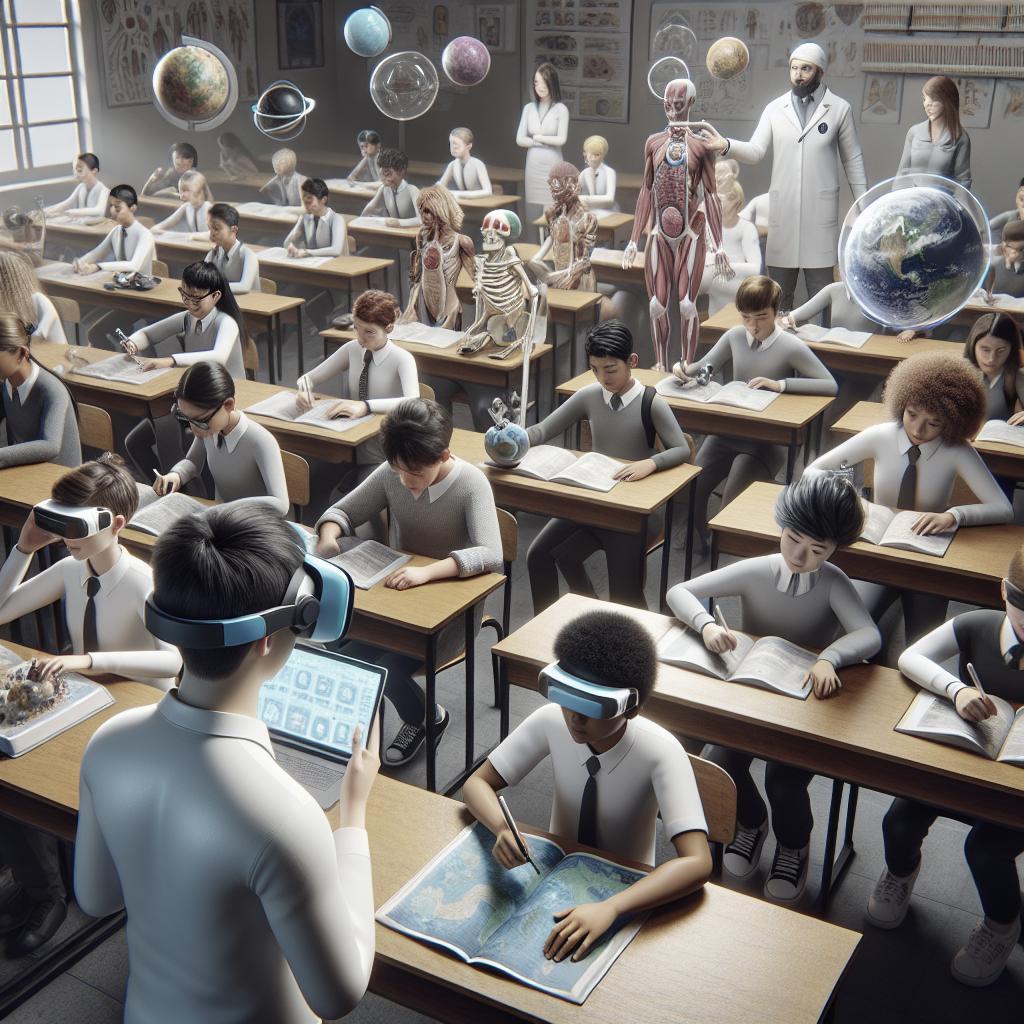“`html
How to Use Augmented Reality in Education
As the education sector continually evolves with technological advancements, augmented reality (AR) emerges as a key player in transforming the learning experience. This blog post explores the significant role AR plays in revolutionizing education by enhancing engagement and comprehension. We will delve into how AR transforms traditional learning, the myriad benefits it brings, its application in professional training, and its impact on eLearning platforms. By the end of this article, readers will have a comprehensive understanding of AR’s potential and practical implementations in modern education.
How AR Is Transforming The Education Industry
Augmented reality overlays digital information such as images, videos, and sounds onto the real world, providing an interactive experience that enhances user engagement and understanding. In education, AR presents content in a way that is dynamic and tangible, making learning more immersive and often more impactful. This technology is gradually being integrated into various educational systems, changing the way students and teachers interact with subject matter.
The education industry is leveraging AR to make concepts that are traditionally taught on paper or screens come alive. For instance, subjects like history, science, and geography can be vastly enriched with AR, allowing students to visualize and manipulate three-dimensional models and simulations. This not only aids comprehension but also fosters curiosity and motivation to explore further.
Augmented Reality In Education
In classrooms worldwide, AR is starting to play a vital role by bridging the gap between theoretical and practical learning. This technology allows abstract concepts to be represented visually and interactively, providing hands-on learning experiences without the logistical constraints of physical materials or locations. For example, biology students can explore the human anatomy through detailed 3D AR models, enhancing understanding of complex systems and structures.
Teachers can also utilize AR to customize learning experiences based on individual student needs. By integrating AR into lesson plans, educators can create tailored educational experiences that cater to different learning speeds and styles, ensuring that no student is left behind. Furthermore, AR applications can facilitate collaborative learning, encouraging students to engage and work collectively in interactive environments.
How Can Augmented Reality Transform The Learning Experience?
Augmented reality has the power to transform the learning experience by making it more interactive and engaging. Traditional educational materials can sometimes fail to capture students’ attention, but AR revamps this aspect by introducing an element of fun and curiosity into the curriculum. With AR, students can engage in a hands-on approach to learning, leading to a deeper comprehension of subjects and concepts.
Additionally, AR can break down geographical and cultural barriers, allowing students from different parts of the world to experience and learn about diverse subjects firsthand. For instance, AR can transport students to historical landmarks or inside molecules, offering a virtual field trip to spaces otherwise inaccessible. This global perspective enhances cultural understanding and broadens students’ worldview, crucial in today’s interconnected society.
Benefits Of AR Technology In Education
The integration of AR technology into education provides numerous benefits, one of the foremost being enhanced engagement. By presenting information in a vivid, multimedia format, AR captures students’ attention and encourages active participation in the learning process. This increased engagement can lead to improved retention rates and academic performance.
Another significant benefit is AR’s ability to provide instant access to contextual information. Students are no longer confined to memorizing static facts from textbooks but can explore interactive educational content that provides real-time data and insights. This immediacy and context make learning more relevant and applicable to real-world scenarios. Additionally, AR fosters creativity, allowing students to experiment and learn through trial and error in a safe and controlled environment.
AR In Professional Training
Outside traditional K-12 and higher education settings, AR is making significant strides in professional training and development. For industries requiring precise, hands-on skills such as healthcare, aviation, and manufacturing, AR provides immersive simulations that prepare trainees for real-world challenges. For example, medical trainees can use AR to simulate surgeries, allowing them to practice and hone their skills without the risks associated with live patients.
Furthermore, AR can streamline training processes by providing real-time feedback and guidance. This interactive element enhances learner engagement and minimizes the learning curve by offering practical, applicable experience. As industries continue to recognize the potential of AR, we can expect to see its increased adoption in professional training programs worldwide.
AR In eLearning Applications
In the realm of eLearning, AR is breaking new ground by enhancing digital courses with interactive elements. Online learners can interact with 3D models, simulations, and virtual environments, adding depth to the digital coursework. This supplementary material can help bridge the gap between traditional online content and the experiential learning that AR offers.
The use of AR in eLearning also facilitates remote collaboration among students. By integrating AR features into group projects or discussions, learners can engage with peers in realistic simulations despite geographical distances. This level of interaction not only bolsters teamwork skills but also enriches the educational experience, making eLearning a more viable and attractive option.
Wrapping Up
As we’ve explored, augmented reality holds immense potential for revolutionizing education at all levels. By transforming the way educators and students interact with information, AR enhances engagement, comprehension, and real-world application of learning. Its adaptability makes it a valuable tool in everything from primary education to professional training and eLearning applications. As educational institutions and companies continue to adopt this technology, the possibilities for enriching the educational landscape are boundless.
| Section | Summary |
|---|---|
| How AR Is Transforming The Education Industry | AR enhances engagement by overlaying digital information in learning, making concepts more tangible and interactive. |
| Augmented Reality In Education | AR aids in teaching complex subjects by allowing interactive exploration, catering to diverse learning styles. |
| How Can Augmented Reality Transform The Learning Experience? | AR makes learning more engaging and interactive, offering global perspectives and breaking cultural barriers. |
| Benefits Of AR Technology In Education | AR improves engagement and retention, providing instant contextual information and fostering creativity. |
| AR In Professional Training | AR offers immersive simulations for skill-based training, enhancing real-world application and learning efficiency. |
| AR In eLearning Applications | AR enriches eLearning with 3D interactions, facilitating remote collaboration and enhancing digital coursework. |
“`


